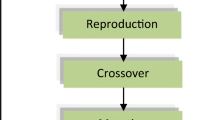Abstract
With the wide spread of image information, it is an urgent problem to protect image property rights and crack down on piracy. Watermarking algorithm is an effective means to solve the problem of copyright protection. In this paper, we propose an optimized image watermarking algorithm based on singular value decomposition (SVD) and integer wavelet transform (IWT). First, the carrier images are divided into blocks. Then, the block-based integer wavelet transform is performed, and the singular value decomposition is performed in the low frequency part. Finally, the first singular value is used to extract energy effectively, so as to improve the robustness of digital watermarking. At the same time, genetic algorithm is used to optimize the robustness and imperceptibility of image watermarking. Four classic gray images, including Lena, baboon, peppers, and Goldhill, are used as carrier images to test, the test results show that the watermarking algorithm has good imperceptibility, and robustness. Compared with other methods, the experimental results show that the algorithm has good PSNR(peak signal-to-noise ratio) and NC(normalized correlation coefficient) values. In the attacks including Gaussian noise, low-pass filtering, changing the size, straight square error equalization, image blur, image contrast, JPEG compression, and gamma correction, the proposed method shows good performance. The NC value of this method is better than that of the contrast method, especially in Gaussian noise attack.







Similar content being viewed by others
References
Adams R, Bischof L (2002) Seeded region growing. IEEE Trans Pattern Anal Mach Intell 16(6):641–647
Xuan TP, Siarry P, Oulhadj H (2018) Integrating fuzzy entropy clustering with an improved PSO for MRI brain image segmentation. Appl Soft Comput 65, S1568494618300097.
Niu Y, Chen J, Wenzhong G (2018) Meta-metric for saliency detection evaluation metrics based on application preference. Multimed Tools Appl Online Public 77(20):26351–26369
Xu Y, Zhu C, Li C, Zhang Q, Meng X, Wang X (2018) Field crop segmentation based on color coefficient reverse mutation particle swarm optimization algorithm. Trans Chinese Soc Agric Eng
Abdulla AA (2015) Exploiting similarities between secret and cover images for improved embedding efficiency and security in digital steganography[D]. The University of Buckingham, United Kingdom
Thakkar F, Srivastava VK (2021) An adaptive, secure and imperceptive image watermarking using swarm intelligence, Arnold transform, SVD and DWT. Multimed Tools Appl 1–18
Priya C, Ramya C (2020) Robust and secure video watermarking based on cellular automata and singular value decomposition for copyright protection. Circ Syst Sign Process DOI:https://doi.org/10.1007/s00034-020-01585-6
Chen X, Li A, Xue’e Z, Wenzhong G, Gang H (2015) Runtime model based approach to IoT application development. Front Comp Sci 9(4):540–553
Chakraborty R, Sushil R, Garg ML (2018) An improved pso-based multilevel image segmentation technique using minimum cross-entropy thresholding. Arab J Sci Eng (13), 1–16
Wenzhong G, Guolong C (2015) Human action recognition via multi-task learning base on spatial-temporal feature. Inform Sci 320, 418–428
Wang S, Guo W (2017) Robust co-clustering via dual local learning and high-order matrix factorization. Knowl-Based Syst 138:176–187
Dong G, Xie M (2005) Color clustering and learning for image segmentation based on neural networks. IEEE Trans Neural Netw 16(4):925–936
Davis LS (1975) A survey of edge detection techniques. Comput Graph Image Process 4(3), 248–270
Ernawan F (2016) Robust image watermarking based on psychovisual threshold. J ICT Res Appl 10(3):228–242
Wang S, Wenzhong G (2017) Robust co-clustering via dual local learning and high-order matrix factorization. Knowl-Based Syst 138:176–187
Samat NA, Salleh MNM (2017) A study of data imputation using fuzzy C-means with particle swarm optimization
Liu G, Huang X, Wenzhong G, Yuzhen N, Guolong C (2015) Multilayer obstacle-avoiding X-architecture steiner minimal tree construction based on particle swarm optimization. IEEE Trans Cybern 45(5):989–1002
Jones G, Willett P, Glen RC, Leach AR, Taylor R (1997) Development and validation of agenetic algorithm for flexible docking 267, 0–748
Kang LL et al (2019) Selecting hyper-parameters of gaussian process regression based on non-inertial particle swarm optimization in internet of things. IEEE ACCESS 7:59504–59513
Kang LL, Chen RS, Cao WL et al (2020) Non-inertial opposition-based particle swarm optimization and its theoretical analysis for deep learning applications. Appl Soft Comput 88: 106038
Kun G, Wenzhong G, Yuzhong C, Qirong Q, Qishan Z (2015) Community discovery by propagating local and global information based on the MapReduce model. Inform Sci 323, 73–93
Lin B, Guo W, Xiong N et al (2016) A pretreatment workflow scheduling approach for big data applications in multicloud environments. IEEE Trans Netw Serv Manage 13(3):581–594
Mirghasemi S, Andreae P, Zhang M, Rayudu R (2017) Severely noisy image segmentation via wavelet shrinkage using PSO and Fuzzy C-Means.Comput Intell
RahkarFarshi T, Demirci R, Feiziderakhshi MR (2018) Image clustering with optimization algorithms and color space. Entropy 20(4), 296
Liu R, Tan T (2002) An SVD-based watermarking scheme for protecting rightful ownership. IEEE Trans Multimedia 4(2):121–128
Niu YZ, Lin W, Ke X et al (2017) (2017) Fitting-based optimization for image visual salient object detection. IET Comput Vision 11(2):161–172
Pham TX, Siarry P, Oulhadj H (2017) Image clustering using improved particle swarm optimization
Ostu N (2007) A threshold selection method from gray-histogram. IEEE Trans Syst Man Cybern 9(1):62–66
Shnayderman A, Gusev A, Eskicioglu AM (2006) An SVD-based grayscale image quality measure for local and global assessment. IEEE Trans Image Process 15: 422–429.
Acknowledgements
The work of Wen Qu was supported by the Science and Technology Research Project in Department of Education of JiangxiProvince under Grant GJJ191599.
Author information
Authors and Affiliations
Corresponding author
Additional information
Publisher's Note
Springer Nature remains neutral with regard to jurisdictional claims in published maps and institutional affiliations.
Rights and permissions
About this article
Cite this article
Zhu, T., Qu, W. & Cao, W. An optimized image watermarking algorithm based on SVD and IWT. J Supercomput 78, 222–237 (2022). https://doi.org/10.1007/s11227-021-03886-2
Accepted:
Published:
Issue Date:
DOI: https://doi.org/10.1007/s11227-021-03886-2




